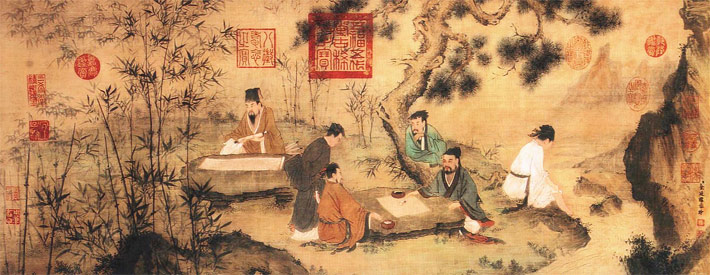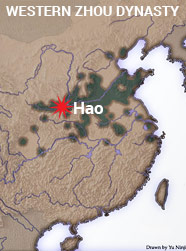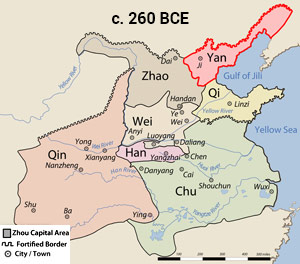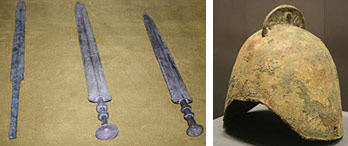
China:
The Spring and Autumn Period (770–476 BCE) and the Warring States Period (476–221 BCE)
The Spring and Autumn and the Warring States Period was the time of the Zhou dynasty and its eventual dissolution politically. The harmonious relationship between Heaven and Earth traditionally maintained by the king gradually disappeared, replaced by crass efficiency and brutality. This period, which must have seemed disastrous for so many, would finally stimulate the surge of creativity that was the Axial Age for China.

In order to manage the administration of the widespread Zhou kingdom, hereditary fiefdoms were given to tribal chiefs in exchange for providing the king with military assistance. These fiefdoms were then divided into smaller counties. The system functioned well for a few hundred years, but gradually the chieftains became more independent and started to behave like warlords rather than subjects. Over time this splintered the domain into many small kingdoms; at one point these numbered around 150.
The power and influence of the Zhou king was eventually reduced to the area of the capital with the petty kingdoms now engaged in almost perpetual warfare. Eventually the stronger and more efficiently run kingdoms conquered the smaller ones. Approximately ten independent kingdoms survived with their nobility more and more refined. The rest of the population was increasingly oppressed; burdened by debt, farmers were forced to become sharecroppers and serfs under the nobility or soldiers in the military.
In 679 BCE Prince Huan of Qi established a league of defense to fill the power vacuum left by the weakened Zhou king. This league suffered a premature demise when Huan died in 643 BCE and his sons, competing for power, pitched Qi into a civil war.
The principality of Chu became increasingly aggressive, so a new alliance was formed against it under the leadership of the Prince of Jin. But Chu defeated this new alliance in 597 BCE and by doing so completely overturned the long-established belief that aggressive states would be punished by the spirits and that Heaven would favor those that practiced moderation and followed the rules and rituals.
Chu’s success clearly challenged the notion that in order to retain the Mandate of Heaven, a state and its leader had to conform to tradition and treat even an enemy with respect. Moreover, it challenged the concept of a supreme ruler for all the Chinese people: a ruler that was The Son of Heaven, who alone had the right to perform the sacrifice to Tian Shang Di or Heaven Most High, at the royal domain.
By 500 BCE the Zhou king no longer had the political and military power to assure the allegiance of the various principalities. Over the centuries, the princes who ruled the peripheral city states had gradually usurped many of the holy functions of the king. Now one of them, the Prince of Chu appeared to be favored by Heaven Most High, despite flaunting the rules of warfare, and performing the traditional rites at his own temple shrine! How could this be? Nothing seemed to make sense.
What had happened to the harmony between Heaven and Earth?
The Warring States Period (475–221 BCE)

The harmonious relationship between Heaven and Earth traditionally maintained by the king had disappeared, replaced by crass efficiency and brutality. This period, which must have seemed disastrous for so many, would finally stimulate the surge of creativity that was the Axial Age for China.
The Zhou dynasty and its traditions were now entirely overwhelmed. A struggle began for military supremacy over China by the main players: Chu, Qi, Qin, Han, Wei, Zhao and Yan.
Warfare became brutal as states fought to wipe each other out. No longer reserved for the fighting elites, warfare now involved entire populations, including peasants. Women and children were murdered; honor and ritual were replaced by discipline and effectiveness. A new cavalry was introduced, more efficient weapons such as crossbows were created, and stronger defenses like the mobile towers which could be pushed up against a city’s walls were used for surprise attack.

The economies of the various kingdoms were greatly stimulated by the need to fund ongoing warfare. Campaigns were expensive and their success depended on new strategies, innovative weaponry and the ability to produce in large numbers all that was necessary for battle. If a kingdom failed to do this, it would be overrun and cease to exist.
By the 4th century BCE, the transition from bronze to cast iron was widespread in China. The production of iron tools gradually improved farming methods. Soil cultivation became widespread and more sophisticated: manure was used and a schedule for plowing, sowing and harvesting was systematized. As trade rapidly increased, merchants became a force to be reckoned with. Some established networks that reached far beyond China—to the north, to the western steppe and even to India. This increased mobility may well have contributed to the spread of ideas between cultures. Cities that had been small, centered on kings, princes and their palaces, now grew rapidly and became centers of trade as well.

Social turmoil was everywhere: the sudden increase in trade, changes in farming methods and the dislocation of large segments of the population disrupted by war destroyed the Chinese version of feudalism in which everyone knew his or her place in society. Now inequalities became increasingly obvious. Peasants were particularly hurt and while some adjusted to the new terms of commerce, many more were forced into indentured servitude.
To this day, Chinese, East and Southeast Asian cultures are shaped by the philosophies that emerged out of the chaos of this time 2,500 years ago. During roughly the same period and against a similar tumultuous background, ancient Greek philosophers developed ideas that would influence the West in a similar manner. Neither were religious nor would become religions, although their fundamental notions are shared by all Axial Sages and other sages, many of whom we know in the context of a religion.
Edward Harper Parker writes in Ancient China Simplified,
All through these five centuries of struggle, between the flight of the Emperor with the transfer of the metropolis in 771 BCE, and the total destruction of the feudal system by the first August Emperor of Ts’ in 221 BCE, it is of supreme interest to note that religion in our Western sense was not only non-existent throughout China, but had not yet even been conceived of as an abstract notion; apart, that is to say, from government, public law, family law, and class ritual. No word for religion was known to the language; the notion of a church or temple served by a priestly caste had not entered men’s minds….
Prayer was common enough, …sacrifice was universal; in fact, the blood of a victim was almost inseparable from solemn function or record of any kind. But such ideas as conscience, fear of God, mortal sin, repentance, absolution, alms-giving, self mortification, charity, sack cloth and ashes, devout piety, praise and glorification—in a word, what the Jews, Christians, Mussulmans, and even Buddhists have each in turn conceived to be religious duty, had no well defined existence at all.
